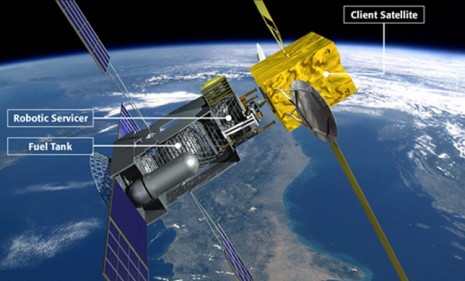The galaxy's first space gas station
Cars aren't the only vehicles that need fuel. And starting in 2014, satellites may be able to line up at the pump, too

When a motorist runs out of gas, it's an inconvenience. For satellites, it's the end of the line: They either fall into the Earth's atmosphere and burn up, or stay in orbit as dead, potentially dangerous space junk. Canadian aerospace company MacDonald, Dettwiler, and Associates (MDA) plans to change that by launching the first-ever orbiting refueling station, a move that's being heralded as the "Holy Grail" of the satellite business and a "huge, huge, huge event." Here, a brief guide:
How will space refueling work?
MDA plans to launch its first Space Infrastructure Servicing (SIS) vehicle in late 2014 or 2015 with enough fuel to service about a dozen satellites. It will travel directly to satellites that are running on empty, refuel them, and, if needed, perform basic repairs with a mechanical arm and other tools. (See a video below.)
The Week
Escape your echo chamber. Get the facts behind the news, plus analysis from multiple perspectives.

Sign up for The Week's Free Newsletters
From our morning news briefing to a weekly Good News Newsletter, get the best of The Week delivered directly to your inbox.
From our morning news briefing to a weekly Good News Newsletter, get the best of The Week delivered directly to your inbox.
What is so great about that?
It should save companies and governments a lot of money. A garden-variety communications satellite costs hundreds of millions of dollars to build and launch, and a top-of-the-line spy satellite can easily cost $3 billion. They generally run on solar power, but rely on fuel for the booster rockets that keep them in orbit. That fuel runs out in about 10 to 15 years, and extending that life cycle means not sending up replacement satellites. The SIS craft will also help deal with our space-junk problem.
How will it get rid of space junk?
Around 370,000 pieces of defunct satellite parts, abandoned shuttle parts, and scraps of metal and paint are orbiting Earth, and could make space too dangerous to fly in. Keeping aging satellites alive and running helps. But the SIS station can also steer dead satellites and other debris further out into "graveyard orbit," or down to flame out in the Earth's atmosphere.
A free daily email with the biggest news stories of the day – and the best features from TheWeek.com
Gas is getting pricey here on earth. How much will it cost in space?
A lot. But "four years before the first space-based gas station will become available, a line has already formed for use of the pump," says Stephen Messenger at Treehugger. MDA's first client is Luxembourg-U.S. satellite giant Intelsat, which signed a seven-year, $280 million contract for the SIS orbiter to fuel and service its satellites.
Sources: Space.com, Wall St. Journal, DVICE, Treehugger
-
 What role will Trump play in the battle over Warner Bros. Discovery?
What role will Trump play in the battle over Warner Bros. Discovery?Today’s Big Question Netflix and Paramount fight for the president’s approval
-
 ‘The menu’s other highlights smack of the surreal’
‘The menu’s other highlights smack of the surreal’Instant Opinion Opinion, comment and editorials of the day
-
 Education: More Americans say college isn’t worth it
Education: More Americans say college isn’t worth itfeature College is costly and job prospects are vanishing